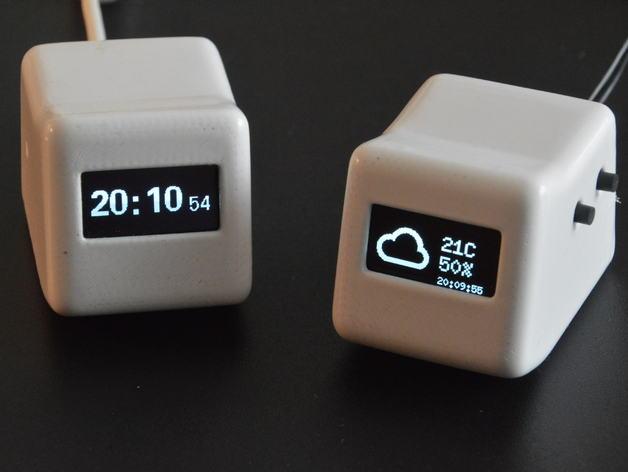
The Desktop Widget is a small, sleek-looking device that displays the weather and the time wherever in the world you happen to be–or not. That is, you may want to call a business contact overseas but would prefer not to wake them up from a sound sleep–definitely not a brilliant business move. Or, you may want to know what the weather is like back home as you’re preparing yourself for your return flight. Whatever the particulars, Ries’ Desktop Widget is one of those gadgets that’s small but enormously helpful.
Ries’ 3D printed Desktop Widget is also pretty easy to construct. In addition to explaining the impetus behind the project, he shared instructions for making the device, a supplies list, and .stl files on Thingiverse.
In terms of the electronic components, you will need a 128 x 64 OLED and an ESP8266 Wi-Fi module. Here’s a quick primer: An ESP8266 is a self-contained system on a chip (SoC) or system on chip (SOC). An SOC is an integrated circuit (IC). It integrates all components of a computer or other kind of electronic system into a single chip. It might contain analog, digital, mixed-signal, and often radio-frequency functions. You can get an ESP8266 from SparkFun or Adafruit for less than $7. The OLED (organic light-emitting diode) provides the visuals for the Desktop Widget. It’s the small graphic display. You can get one from Adafruit for less than $25.
When Ries designed the case for the device, he wanted something contemporary looking and thought specifically of the German product manufacturer Braun which is well known for its clean-lined, functionalist aesthetic. However, the resulting design, he felt, owes more to a Star Wars than a German Modernist aesthetic–definitely not a bad thing as influences go!
“I had a simple, ‘BRAUN’-style design in mind,” Ries said. “But [the finished] result doesn’t remind [me of] a BRAUN device very much. For me it rather associates with the helmet of a star wars storm trooper.”
The first iteration of the Desk Widget had no control buttons. A second one had two push buttons, which interfered with Ries’ preferred aesthetic, so he designed a new version that operates with a gesture sensor. For hosting the electronics there are also two options: One with the OLED display and the ESP8266 and one with an additional Arduino Pro Mini. As for the 3D printing, support was not required and the case was printed at the highest resolution (0.2mm). Some sanding was required post-printing and Ries also used acetone for additional smoothing out.
The last step in producing the Desktop Widget is the programming. Ries provided a link to a forum where the source code (LUA) can be accessed. Up and running, the device will provide you with the time, temperature, and humidity every 10 minutes. This unassuming device will keep you in the know in the location of your choice. For local weather conditions, you can always glance out a window.
Let us know if you might create your own handy gadget in the 3D Printed Desktop Widget forum thread over at 3DPB.com.